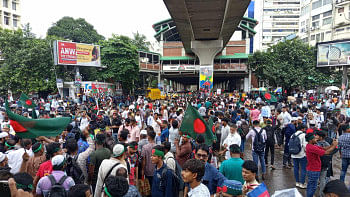Virtual marketplace:Big opportunity awaits RMG

Technology is proving to be a game-changer in the fashion industry. From manufacturing to marketing, the touch of technology is no longer a luxury, it is a necessity. That is why a technological transformation is taking place at great speed both at organisational and industry levels not only in Bangladesh, but across the globe.
An increasing number of readymade garment (RMG) factories in Bangladesh are embracing digitisation and automation in the manufacturing process to increase productivity, reduce costs and lead time etc., which are prerequisites to stay competitive in the global sourcing supply chain.
But it is an irony that Bangladesh, feted as the world's second largest apparel exporter, is yet to develop a virtual marketplace to showcase its products, and connect global buyers and consumers with local manufacturers. In absence of such a common platform, apparel manufacturers are solely dependent on a traditional brick and mortar system; that too in a time when we as a country boast of building "digital Bangladesh".
The internet has significantly changed our lives as well as businesses. One after another, companies have been going online since the inception of this technology and then Covid-19 accelerated the pace of digital transformation, leading to a boom in the digital and e-commerce sectors.
In fact, it has become so popular that the online transition will stay even after the pandemic is over.
The penetration of online technology is going to grow and at one point the entire global population will use the Internet.
The greater the penetration, the bigger will be the size of e-commerce, which is bound to have lasting impacts on our apparel business for which we must prepare.
In the US, online sales accounted for 46 per cent of its total apparel sales in 2020.
Brands and retailers had experienced a big jump in digital sales and revenue collection with GAP reporting that in the second quarter of 2021, their online sales grew by 65 per cent and now represents 33 per cent of its total revenue.
Similarly, Inditex reported that online sales now account for 77 per cent of their total sales and throughout 2020, online visits to the brand reached 5.3 billion, up 50 per cent compared to the previous year.
Zalando also reported 32 per cent to 34 per cent growth in its gross merchandise value during the second quarter of 2020.
UK retailer Boohoo claimed a 45 per cent increase in revenue across all of its (primarily online) fashion brands during the same period.
Myntra, an Indian fashion marketplace, saw a record 19 million visitors on its website just on the first day of its annual sales festival in 2021.
Therefore, it would not be an exaggeration to say that online sales helped the fashion industry stay afloat during the devastating period of Covid-19 and will determine the sector's future growth momentum.
Thanks to the mass vaccination programme, normalcy has returned across much of the world. Interestingly though, a portion of consumers have become so accustomed to the "new normal" that they still favour shopping online rather than physically visiting the stores.
Apparently, the convenience and comfort of online shopping is driving them towards this choice. Fashion is the largest business-to-consumer e-commerce market segment with a global value of $664.5 billion which is projected to reach $1003.5 billion by the end of 2025.
Bangladesh being the second largest apparel exporter in the world has huge untapped potential in that chunk.
There is no denying that our apparel industry has come a long way since its inception. What began with a meagre yearly export income of $10,000 has now reached the milestone of fetching $34.13 in FY2018-19.
QIMA ranked us second in ethical manufacturing while the US Green Building Council bestowed us with the Global Leadership Award.
However, it is regretful that in all these years we have failed to create our own brand story.
So far, Bangladesh has only prevailed as a manufacturing hub and in spite of having 40 years of experience in apparel manufacturing, we are still lacking design development and innovation.
The virtual marketplace can finally open up an opportunity for us to shift from custom makers to make our mark in the global stage.
The virtual marketplace can also be a gateway for local small-and medium enterprises (SMEs) to go global.
Consumers have emerged from the pandemic into a new economic reality, where they are finding a limited quantity of custom-made products.
This particular choice can create an opportunity for SME factories, which are attributed to sell multiple items in smaller quantities.
This is altogether a different slot in the market to pitch in. Considering the present business context in Bangladesh, where SMEs are endangered by uneven competition with large enterprises, tapping the virtual market can be a way to carve out a niche for them.
Now, there are two alternatives for Bangladesh to enter the virtual marketplace. Individual factories can sell their products through already existing platforms like Amazon, Walmart and E-bay or we can develop our own marketplace as a dupe existing ones with further developments and features.
The operating procedure can also follow two modalities: business-to-business or business-to-consumer. Either way, the website has to be updated and upgraded with an assortment of features of our own design.
In order to smoothly run the operation, modifications in our existing Bangladesh Bank, National Board of Revenue, Export Promotion Bureau, and other policies is a must.
Besides, some issues regarding discrepancies in documents.
For example, when shop owners offer discounts, reject goods, issue bonds, regulates foreign exchange and most importantly, manage warehouses for faster delivery, all relevant documents have to be cross-checked with the country's laws to ensure compliance.
Moreover, we have to work on branding and marketing so that we can make our venture into the virtual marketplace a success. Since there is no scope for consumers to touch, smell or physically feel the goods before purchasing, there is always a trust issue. So, customers have a tendency to repurchase from the same shop if they are given a fair deal.
If we enter Amazon or E-bay, we have to keep in mind that we will be competing against brands like H&M, Zara, M&S, Ck, GAP and other famous global brands. Although this may sound like an uphill task, it is not impossible.
At birth, Bangladesh was branded as a bottomless basket but it is now considered a role model for development across the world.
We have secured graduation from the UN's group of least developed countries and now aim to become a developed country by 2041.
With the garments sector being the main economic pillar of Bangladesh, it has a crucial role to play in fulfilling the country's development goals.
The industry has so far managed to prevail against all odds and is committed to achieving even higher levels of excellence.
It has a vast experience in manufacturing and offers competitive prices so with a little nudge in the right direction, we could create the next Amazon right here in Bangladesh.
Therefore, solutions to bottlenecks for entering the virtual marketplace must be urgently sought before this opportunity slips away.
The writer is the president of Bangladesh Garment Manufacturers and Exporters Association (BGMEA).

 For all latest news, follow The Daily Star's Google News channel.
For all latest news, follow The Daily Star's Google News channel. 



Comments